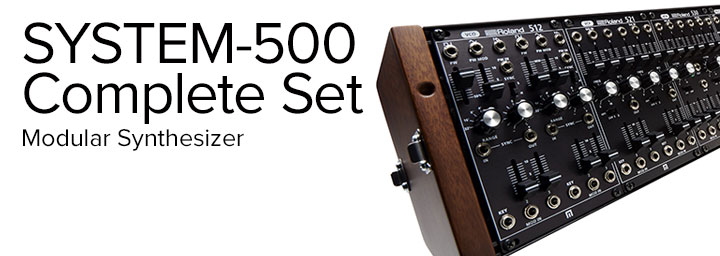The Roland SYSTEM-500 Complete Set is a fully analog recreation based on Roland’s classic SYSTEM-100M. The modules have been adjusted to conform to the Eurorack standard. Below is a list of some other enhancements and useful bits of information to help you get the most out of the modules.
 Contributed by Roland Canada
Contributed by Roland Canada

 Contributed by Roland Canada
Contributed by Roland Canada
1. The SYSTEM-500 is Ready to Play
The SYSTEM-500 Complete Set comes with all five modules, a power supply, and a Eurorack case. It is ready to start patching right out of the box. The SYR-E84 case comes with a cover and carrying handle, making it convenient for gigging musicians.2. Normalized KEY Inputs
The 512 module contains two identical voltage controlled oscillators. The KEY CV inputs are normalized to be linked together. This means that both oscillators will track to the same CV when voltage is sent to only one KEY input. This is useful when creating sounds that use two oscillators. The range controls still work independently for each oscillator, allowing them to be tuned apart by whole octaves. This can come in handy when creating a sub oscillator or for FM sounds.3. High Pass Filter
The 521 module contains two 24db low pass filters. In addition, there is also a high pass filter with two cutoff settings. This can be used to shave off the low end from the output of the filter.4. Six Channel Mixer
The 530 module contains two voltage controlled amplifiers. Each amplifier has three inputs, each with its own level control. The SUM outputs are a mix of the outputs from both amplifiers. This allows the 530 to be used like a six channel mixer.5. Cycle Mode
The 540 module contains two envelope generators and a low frequency oscillator. The envelope generators can be switched to cycle mode. This allows them to be used like two additional low frequency oscillators, with the attack and decay times controlling the rate and shape.6. Normalized Effect Modulation
The MOD source for both the phaser and delay in the 572 module are normalized to the module’s LFO, so you can modulate the effects without any patching.7. Extended Delay Time
The range of the delay effect in the 572 has been extended beyond that of the original 172 module. The first half of the DELAY TIME knob is the entire range of the original module, and the second half has a longer delay time. This longer time allows the clock signal to be lowered into audio range. Use a low pass filter to remove the high frequency tone from the clock.8. Extra Octave
The octave switches on the 512 module can turn beyond the indicators on the panel. This gives an extra octave of range.Related Articles
TR-8 AND EFFECTS – PART 3: MODULAR EFFECTS ROLAND ICON SERIES: THE ROLAND SYSTEM-100 SYNTHESIZER AIRA MODULAR: WHAT IS A MODULAR SYNTHESIZER? THE A-TO-Z OF SYNTHESIZER TERMSRelated Product

